Libraries in the Digital Age: Stil a Key Infrastructure
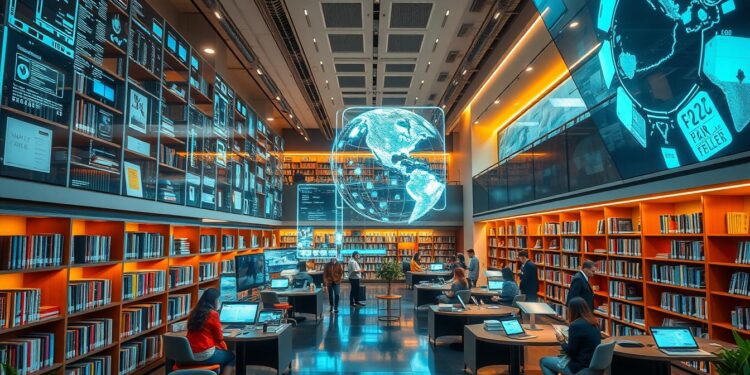
Libraries are changing into dynamic digital centers. They are now more than just places for books. They offer a mix of physical and digital resources.
Digital preservation is key for today’s libraries. They manage big digital collections. This lets people access information in new ways.
The Digital Public Library of America, started in 2010, shows how libraries are changing. They meet the needs of today’s users.
Public libraries are more than just book places. They help everyone get online and learn new things. They support learning, research, and digital skills for all.
Table of Contents [hide]
- 1 The Evolution of Modern Libraries: Beyond Book Repositories
- 2 Libraries in the Digital Age Infrastructure: Transforming Spaces and Services
- 3 Digital Technology’s Impact on Research and Scholarship
- 4 The Role of Libraries in Digital Literacy and Education
- 5 Community Hub Functions: Creating Inclusive Spaces
- 6 Digital Preservation Challenges and Solutions
- 7 The Transformation of Library Services in the Internet Age
- 8 Libraries as Centers for Innovation and Technology
- 9 Bridging the Digital Divide: Access and Equity
- 10 The Future of Library Collections: Physical and Digital Integration
- 11 Knowledge Management and Information Organization
- 12 Supporting Academic and Professional Development
- 13 Conclusion
Key Takeaways
- Libraries are transitioning from traditional book repositories to digital information centers
- Digital preservation has become a critical mission for modern libraries
- Libraries now provide complete digital and physical resource access
- Technology has expanded libraries’ roles beyond traditional information storage
- Public libraries continue to serve as critical community infrastructure
The Evolution of Modern Libraries: Beyond Book Repositories

Libraries have changed a lot in the digital age. They are now more than just places for books. They offer both physical and digital resources. Over 60% of libraries have added more technology, showing a big change in how we manage knowledge.
The digital age has changed library services a lot. Here are some key stats:
- 85% of library users now access digital resources
- 72% of librarians see digital literacy programs as key
- 58% of patrons use libraries for tech help
From Traditional Collections to Digital Resources
Modern libraries are more than just shelves of books. They have digital collections, databases, and multimedia. Digital tools have replaced old card catalogues, making it easier to find information.
The Continuing Relevance of Physical Books
Physical books are very important in libraries. Even with more digital options, print materials offer something special. About 90% of library users want access to both physical and digital books, showing the need for a mix.
Hybrid Service Models
Libraries are creating new ways to mix physical and digital experiences. They offer virtual book clubs, online talks with authors, and ways to keep historical materials safe and accessible.
“Libraries are no longer just repositories of books, but dynamic centers of community learning and technological innovation.”
The change in library services shows a move towards more user-focused, tech-savvy approaches. These changes meet the needs of today’s information seekers.
Libraries in the Digital Age Infrastructure: Transforming Spaces and Services

Libraries are changing a lot in the digital age. They are not just places for books anymore. Now, they are community hubs with the latest technology and flexible spaces for everyone.
Libraries are now using new tech in their spaces. They create areas for learning, working together, and using digital tools. These new spaces include:
- Collaborative workstations with high-speed internet
- Digital media labs
- Maker spaces with advanced technological equipment
- Flexible learning zones
Studies show libraries are key in keeping up with tech changes. A study looked at library changes and found interesting facts:
| Infrastructure Component | Transformation Percentage |
|---|---|
| Digital Resource Integration | 65% |
| Technology-Enhanced Learning Spaces | 48% |
| Community Program Diversification | 42% |
“Libraries are evolving from book warehouses to dynamic knowledge ecosystems” – Library Innovation Research Group
The digital age infrastructure means libraries must change. By using new tech, they stay important community spots. They help everyone learn and bridge the digital gap.
Digital Technology’s Impact on Research and Scholarship
The digital revolution has changed scholarly research a lot. It has opened up new ways to access and manage information. Now, researchers can work together better than ever before.
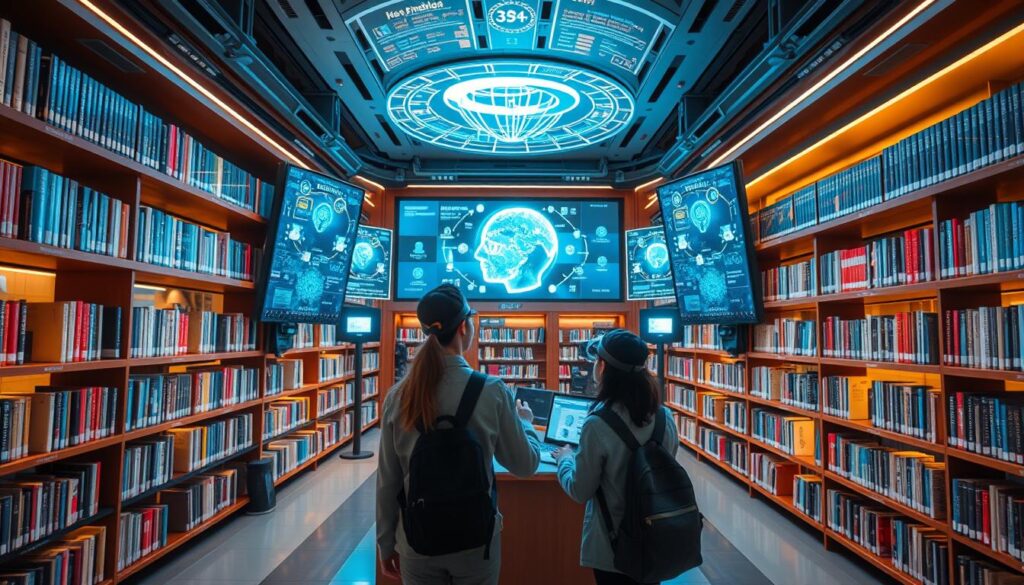
Digital tools have changed how researchers work. They have powerful tools to explore, analyze, and share information. This has made research faster and more connected worldwide.
AI Tools and Research Efficiency
Artificial intelligence is a big help for researchers. AI tools can:
- Rapidly analyze complex datasets
- Identify research patterns
- Generate preliminary insights
- Streamline literature reviews
Digital Archives and Database Access
Digital archives have changed how we access information. Scholars can now:
- Access global scholarly resources instantly
- Explore interdisciplinary materials
- Conduct thorough literature searches
Collaborative Research Opportunities
“Technology has transformed research from a solitary endeavor to a global collaborative experience.” – Research Innovation Network
Digital platforms make it easy to work together in real time. Researchers from all over can collaborate smoothly. Cloud-based tools and shared digital workspaces are key for modern research.
But, researchers need to be good at using digital tools. They must learn to find and check online information well.
The Role of Libraries in Digital Literacy and Education
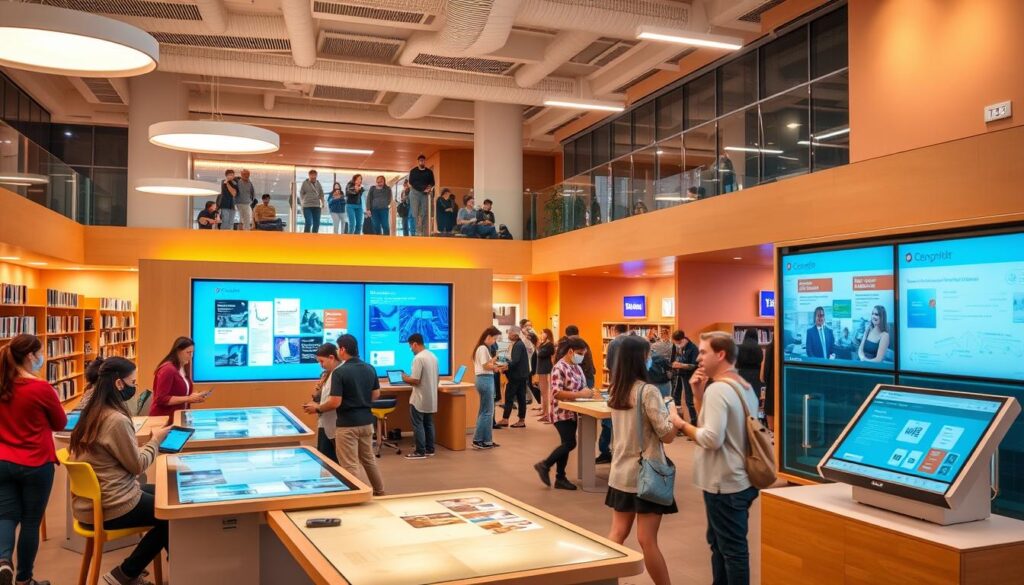
Libraries are key in today’s world for digital skills and information. Almost half of the world’s people don’t have internet. Libraries help by teaching digital skills and giving access to information.
Digital literacy programs are a big part of what libraries do. Libraries are changing from just book places to places for learning. They teach important tech skills and offer resources.
“Libraries level the playing field by giving free access to tech and learning resources”
Some important digital literacy efforts include:
- Computer skills training
- Online safety workshops
- Technology device lending programs
- Free internet access
- Digital resource workshops
Numbers show how libraries’ digital literacy work helps:
| Program Type | Percentage of Libraries With It |
|---|---|
| Digital Literacy Programming | 88% |
| Technology Training Programs | 85% |
| Community Digital Skills Workshops | 70% |
Libraries keep changing to make digital skills available to everyone. This includes people of all ages, incomes, and backgrounds.
Community Hub Functions: Creating Inclusive Spaces
Libraries have changed from just book places to lively community centers. They now help people connect and learn about technology. With over 17,000 public libraries in the U.S., they are becoming key spots for community and learning.
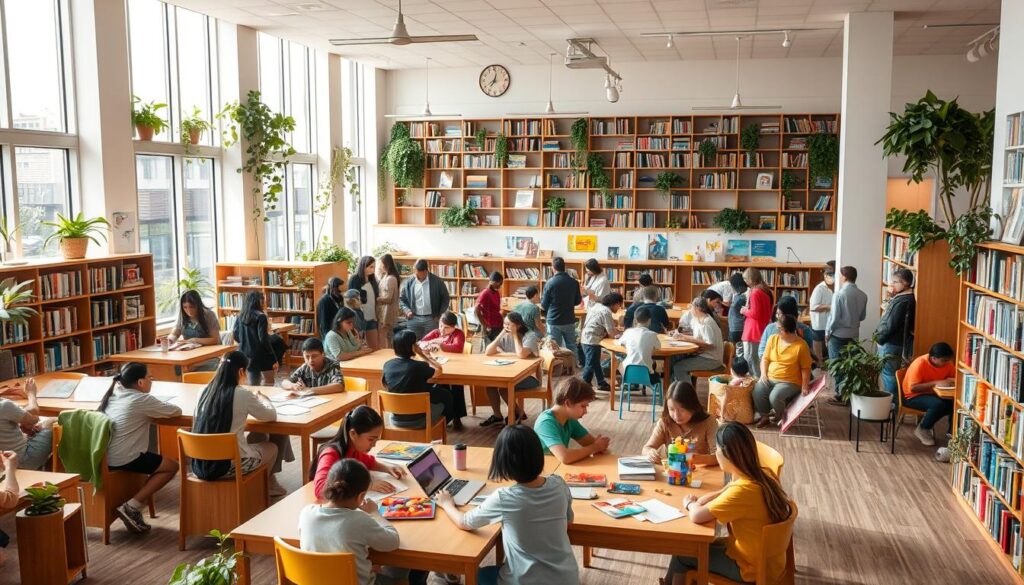
Today’s libraries are stepping out of their old roles. They offer new spaces for different community needs. They are key for people to meet, learn, and get access to technology.
Makerspaces and Innovation Centers
Libraries now have makerspaces for creativity and learning by doing. These places are full of technology. They give communities:
- 3D printing workshops
- Digital design labs
- Collaborative engineering spaces
- Technology skill development programs
Cultural Programs and Events
Libraries host cultural events that bring people together. They have:
- Language exchange sessions
- Art exhibitions
- Musical performances
- Author talks and book clubs
Social Engagement Opportunities
“Libraries are the cornerstone of democracy, providing equal access to information and opportunities for all.” – Anonymous Librarian
Libraries are vital for those in need. They offer safe places, free internet, and support. With 61% of libraries being the only free internet spot, they help close the digital gap.
Libraries are changing by mixing technology, learning, and community. They are becoming essential public spaces. They empower people and build stronger social bonds.
Digital Preservation Challenges and Solutions

Libraries face big challenges in keeping digital materials safe. The world of technology changes fast. Digital stuff doesn’t last as long as old books or films, making it urgent to find good ways to keep it safe.
The world of digital preservation shows us how fragile digital media is:
- Digital media usually lasts only 3-50 years
- Old media can last 10-2200 years
- Keeping digital stuff safe gets more expensive as more data is made
Keeping digital stuff safe needs smart solutions. Libraries are looking into new ways like emulation technologies and better ways to move data to new systems. The Internet Archive’s work on saving old computer games shows how to keep digital stuff alive.
“The last fifteen years produced more records than any previous similar period, with significant challenges in reliability and accessibility.” – Professor Luciana Duranti
New plans from countries like Estonia are exciting. They want to create big digital libraries that bring together all the digital stuff from museums and archives. Keeping digital stuff safe now means dealing with old technology, making sure data is right, and making sure it’s easy to find later.
Big challenges in keeping digital stuff safe include:
- Technology changing too fast
- Old hardware breaking down
- Keeping track of different versions
- Metadata not being consistent
Libraries and archives must keep up. They need to use tools and systems that can grow with the amount of digital stuff they have. This way, they can keep digital resources safe for the future.
The Transformation of Library Services in the Internet Age
Libraries have changed a lot in the digital age. They now offer new virtual services and ways to access information. Gone are the days when libraries were just places to find books. Now, they are dynamic digital platforms.
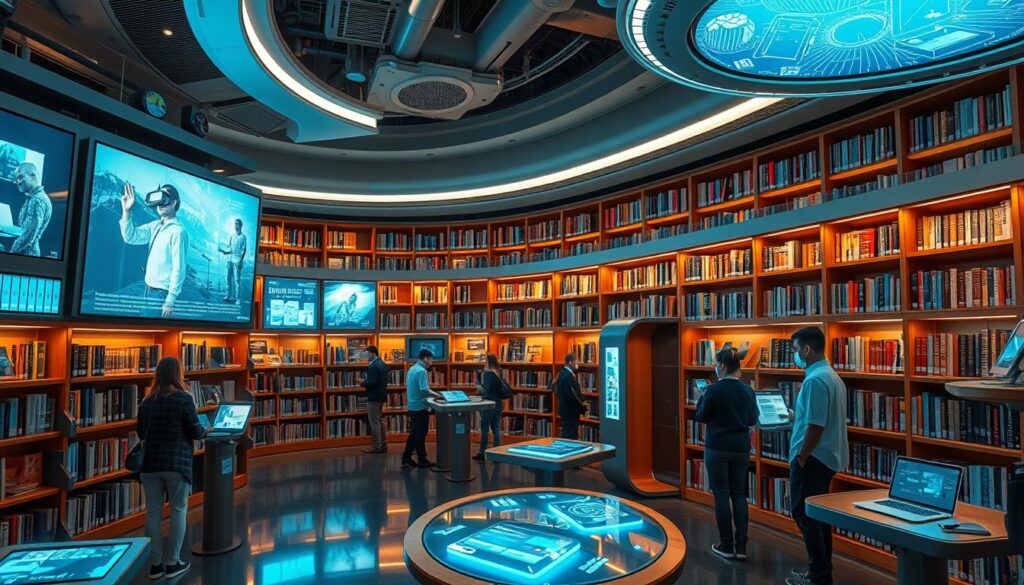
The digital age has changed how libraries serve users. They now offer more accessible and flexible ways to find information.
Virtual Reference Services: Connecting Beyond Physical Spaces
Today, libraries offer virtual reference services. These services let users:
- Get help with research online
- Get instant expert advice
- Connect with librarians online
- Get personalized research help from anywhere
Online Resource Access: Expanding Information Horizons
Digital platforms have changed how we access information. Libraries now have online collections that include:
- Digital journals and academic publications
- Electronic books
- Multimedia research databases
- Specialized digital archives
Remote Learning Support: Bridging Educational Gaps
Libraries are key for remote learning. They offer digital resources to support learning. Their services include:
- Online learning platforms
- Webinars and tutorials
- Interactive research workshops
- Digital skill development programs
“Libraries are no longer places where information is stored, but dynamic spaces where knowledge is accessed, shared, and created.”
| Service Category | Digital Transformation Impact |
|---|---|
| Reference Services | 24/7 Online Accessibility |
| Resource Access | Global Information Reach |
| Learning Support | Flexible Educational Resources |
These digital changes show libraries’ dedication to keeping up with technology. They make sure everyone can access important information easily and efficiently.
Libraries as Centers for Innovation and Technology
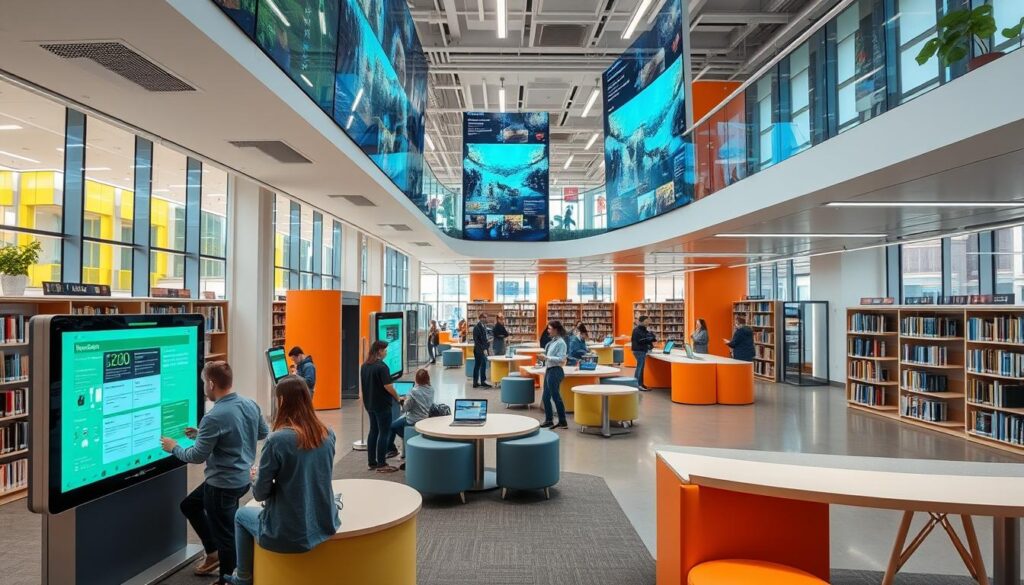
Modern libraries are changing into vibrant centers of technology and community. They now offer advanced resources beyond just books. With technology getting easier to use, libraries are key spots for innovation in local areas.
Libraries lead in making technology accessible through various programs and tools:
- 3D printing workshops
- Virtual reality experiences
- Digital media production equipment
- AI-assisted research tools
The tech scene in libraries is seeing big changes:
| Technology Service | Percentage of Libraries Offerings |
|---|---|
| Internet Hotspots | 46.9% |
| Digital Media Production | 24.6% |
| Maker Production Equipment | 39.5% |
| Digital Literacy Training | 95.3% |
“Libraries are no longer just repositories of knowledge, but active platforms for technological exploration and community development.”
Community involvement is a big deal now. Libraries are making places where everyone can use technology. They offer programs and training to help people learn digital skills, no matter their income.
The future of libraries is all about being digital. They are changing to offer new services that meet today’s tech and learning needs.
Bridging the Digital Divide: Access and Equity
The digital divide is a big problem today, stopping people without tech and digital tools. Libraries are key in solving this issue. They offer digital skills and access to info for those who need it most.

Worldwide, about 54.8 percent of households have internet access. This means nearly 45 percent are missing out. This issue hits hard on low-income families, rural areas, and students of color.
Public Internet Access
Libraries are changing lives by giving free internet. They are digital doors for those who can’t afford it. They offer:
- Free Wi-Fi hotspots
- Public computer terminals
- Extended access hours
- No-cost digital resource centers
Technology Training Programs
Knowing how to use tech is key today. Libraries have programs for all kinds of people:
- Basic computer skills workshops
- Online safety courses
- Job search technology training
- Multilingual digital education resources
Digital Resource Accessibility
Libraries make sure everyone can use digital tools. They create special programs for different groups:
| Population Group | Accessibility Strategies |
|---|---|
| Seniors | Gentle technology introduction classes |
| Non-native speakers | Multilingual digital literacy resources |
| Individuals with disabilities | Adaptive technology workshops |
“Libraries are the great equalizers in bridging technological inequalities” – Digital Inclusion Research Institute
Libraries keep working hard to make sure everyone has a chance to use tech. They are key in making our communities more equal.
The Future of Library Collections: Physical and Digital Integration
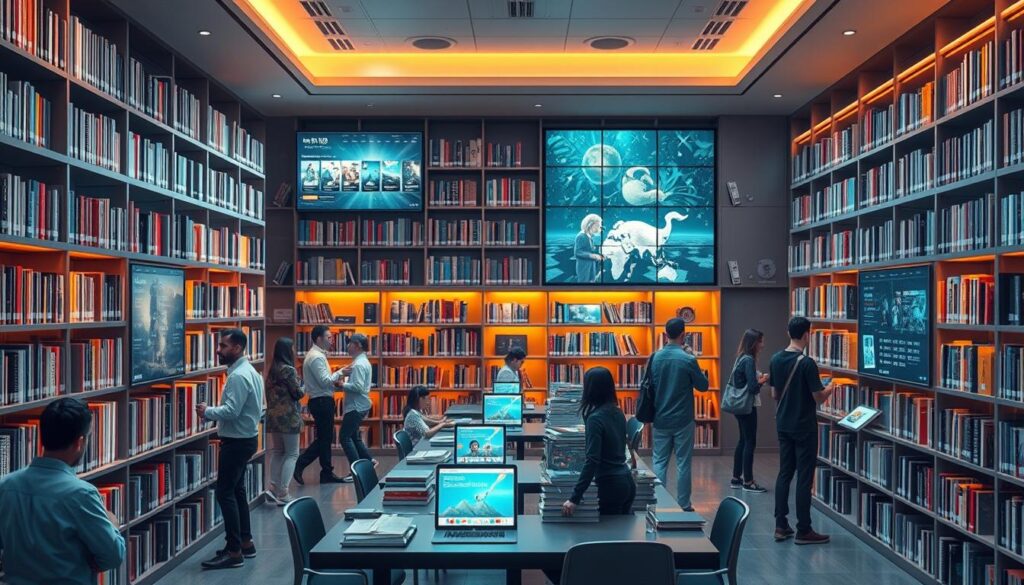
Libraries are changing by mixing physical and digital items. The world of digital preservation is growing fast. It brings new ways to manage knowledge that meet many needs.
Today’s libraries aim for a mix of old and new. They want to be open and full for everyone, no matter how they learn.
- 95% of public libraries now offer eBooks and digital audiobooks
- 58% provide streaming and downloadable media
- 47% offer mobile hotspots for internet access
- Approximately 25% have digital media production equipment
Mixing physical and digital items is tricky. Librarians must keep up with new tech while also supporting old ways of learning.
“Libraries are no longer just book repositories but dynamic knowledge centers bridging physical and digital worlds.”
Digital preservation is key in this change. Libraries use advanced systems to keep digital items safe. They make sure these items stay the same and are easy to find later.
| Collection Type | Percentage of Libraries |
|---|---|
| Digital Literacy Training | 95% |
| Maker Production Equipment | 40% |
The future of libraries is about being flexible and connected. They will keep being important places for learning in our digital world.
Knowledge Management and Information Organization

Libraries have changed a lot. They now handle digital information in new ways. This change is thanks to better ways of organizing data.
Peter Drucker said in 1965 that knowledge is key. Today, libraries use new systems to share and organize information.
“Knowledge is the chief source of production, surpassing land, labor, capital, and machines.” – Peter Drucker
Libraries use several ways to manage knowledge:
- Creating big digital collections
- Making information easier to find and share
- Building better places for working together on information
- Seeing knowledge as a valuable resource
Libraries use the latest tech to make data easier to handle. Metadata standards, the semantic web, and linked data help find and organize information better.
The Gartner Group says knowledge management is about working together. Libraries are now places where old and new research meet.
Library workers use special tools to handle lots of information. Tools like Evernote and OneNote help them keep everything organized.
Supporting Academic and Professional Development
Libraries have changed a lot. They are now centers for information and community. They offer many resources for learning and growing.

Today, libraries play a big role in helping people learn and advance in their careers. They use new ways to meet different learning needs.
Research Support Services
Libraries now help with advanced research. They support scholars and professionals in many ways:
- Comprehensive literature review assistance
- Data management consultation
- Research methodology workshops
- Publishing guidance and manuscript preparation
Professional Development Resources
Libraries are key places for improving skills. They offer:
- Online learning platforms
- Digital skills training
- Career development workshops
- Industry-specific resource collections
Career Enhancement Tools
Libraries help with career growth. They have the right tools for it:
“Libraries are no longer passive repositories of information, but active catalysts for professional transformation.” – Library Innovation Research Group
Libraries mix technology and human help. They make places where everyone can keep learning and growing.
Conclusion
Libraries have become key digital infrastructure, changing with technology while keeping their core mission. They are now more important than ever, connecting people with information. With more online resources than ever, they help communities access knowledge.
The rise of digital platforms like WorldCat Local shows libraries’ big leap forward. It offers access to over 100 million titles worldwide. This shows how libraries have evolved.
Libraries’ digital change is more than just new tech. It’s a new way to access and engage with information. Digital literacy classes now help about 4,000 students each year. This shows libraries’ growing role in education.
Platforms like iTunes U, with over 4,000 weekly downloads, highlight libraries’ use of tech. They make learning more accessible than ever.
Looking to the future, libraries will keep being vital in our digital world. They preserve history, offer tech access, and support learning. The MacArthur Foundation’s support shows their importance in the digital age.
Libraries bridge the gap between the physical and digital worlds. They don’t just save information; they shape how we learn and understand it. Their ability to adapt makes them essential to our collective knowledge.





